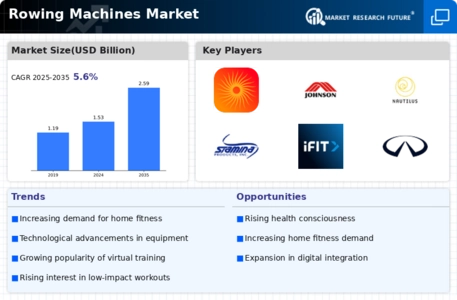Market Growth Projections
The Global Rowing Machines Market Industry is poised for substantial growth, with projections indicating a market value of 1.53 USD Billion in 2024 and an anticipated increase to 2.59 USD Billion by 2035. This growth trajectory suggests a compound annual growth rate (CAGR) of 4.89% from 2025 to 2035. Such figures reflect a growing consumer interest in fitness and wellness, alongside the increasing adoption of rowing machines as a preferred exercise option. The market's expansion is likely to be driven by various factors, including technological advancements, rising health consciousness, and the popularity of home fitness solutions.
Technological Advancements
Technological innovations play a pivotal role in shaping the Global Rowing Machines Market Industry. Manufacturers are integrating advanced features such as digital displays, Bluetooth connectivity, and interactive training programs into their products. These enhancements not only improve user experience but also attract tech-savvy consumers seeking modern fitness solutions. The introduction of smart rowing machines, which can track performance metrics and provide personalized training regimens, exemplifies this trend. As the market evolves, these technological advancements are likely to contribute to the projected growth, with an anticipated market value of 2.59 USD Billion by 2035, reflecting a CAGR of 4.89% from 2025 to 2035.
Increasing Health Awareness
The Global Rowing Machines Market Industry experiences growth driven by a rising awareness of health and fitness among consumers. As individuals increasingly prioritize physical well-being, the demand for effective home workout equipment, such as rowing machines, escalates. This trend is reflected in the projected market value of 1.53 USD Billion in 2024, indicating a robust interest in fitness solutions. Rowing machines offer a full-body workout, appealing to a broad demographic, including both seasoned athletes and fitness novices. The emphasis on maintaining a healthy lifestyle suggests that this driver will continue to influence market dynamics in the coming years.
Diverse Consumer Demographics
The Global Rowing Machines Market Industry benefits from a diverse consumer base that spans various age groups and fitness levels. This inclusivity allows manufacturers to target a wide range of customers, from young athletes to older adults seeking low-impact exercise options. The adaptability of rowing machines makes them suitable for rehabilitation and general fitness, appealing to both fitness enthusiasts and those new to exercise. As the market continues to evolve, understanding and catering to the unique needs of these diverse demographics will be crucial for sustained growth and innovation in the rowing machine sector.
Rising Popularity of Home Fitness
The Global Rowing Machines Market Industry is significantly influenced by the increasing trend of home fitness. As more individuals opt for home workouts due to convenience and flexibility, rowing machines have emerged as a favored choice. This shift is particularly evident in urban areas where space constraints make compact fitness equipment appealing. The versatility of rowing machines, which can provide an effective cardiovascular workout while also building strength, aligns well with the preferences of home fitness enthusiasts. This growing inclination towards home-based exercise solutions is expected to sustain the market's upward trajectory, contributing to its overall expansion.
Government Initiatives and Support
Government initiatives aimed at promoting physical fitness and healthy living contribute positively to the Global Rowing Machines Market Industry. Various health campaigns and programs encourage citizens to engage in regular physical activity, thereby increasing the demand for fitness equipment. Governments may also provide subsidies or incentives for fitness-related purchases, further stimulating market growth. Such initiatives not only raise awareness about the importance of exercise but also facilitate access to fitness resources. As these programs gain traction, they are likely to bolster the market, fostering a culture of health and fitness that benefits the rowing machine sector.

























